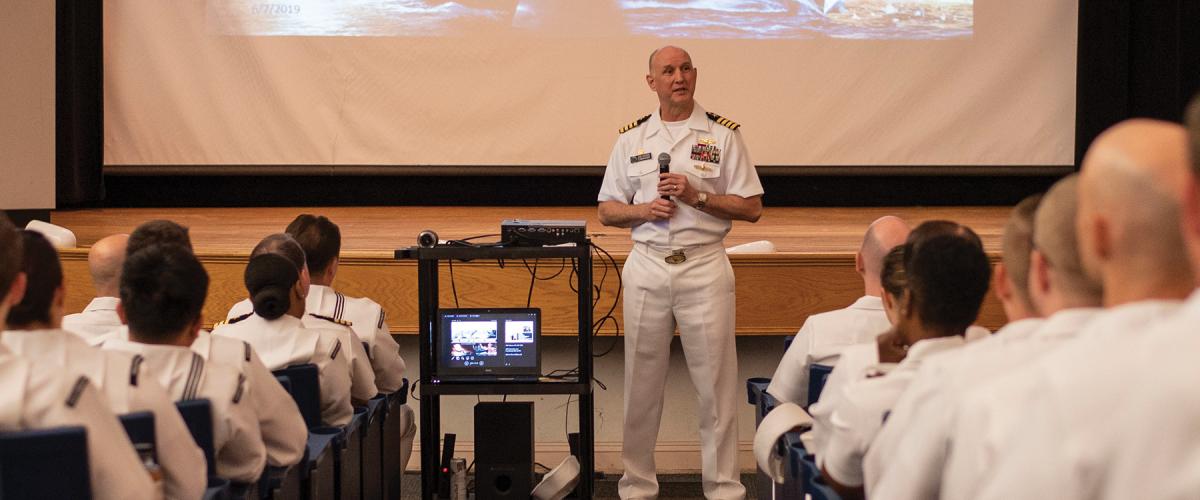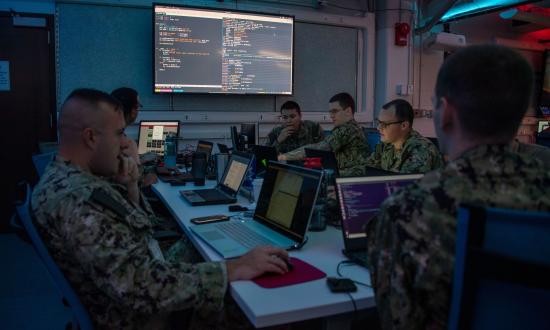The term subject matter expert (SME) is used extensively in the Navy information warfare community, but often to support promotion recommendations rather than define an officer’s mastery of a specialty. In fact, the career path for cryptologic warfare officers (CWOs) does not support growing regional experts, but instead is one in which broad exposure is valued over mastery. The cryptologic warfare community has long preferred the generalist officer model.
However, this model is no longer viable in the face of the growing threat in the Pacific. Indeed, World War II provides an outstanding example of how a SME contributed directly to the U.S. Navy’s victory at the June 1942 Battle of Midway, considered the turning point for the war in the Pacific. As is well known, then-Commander Joseph J. Rochefort led his team of cryptographers in breaking the JN-25 code, which allowed Admiral Chester Nimitz to anticipate the attack on Midway and position his forces accordingly.1
While Rochefort’s career took many turns after he enlisted at age 17 just before the end of World War I, from the late 1920s through the 1930s he was focused on the Pacific and Japan in particular (he lived in Japan and studied the language from 1929 to 1932). In June 1941, Rochefort was assigned as officer in charge of the Combat Intelligence Unit at Pearl Harbor, Hawaii (also known as Station Hypo). His career path is a possible blueprint for how to develop CWOs to better focus on a single threat.2
Today’s Cryptologic Warfare Officer
Today’s CWOs know their promotable status depends on getting experience in three core CW disciplines: electronic warfare (EW), signals intelligence (SigInt), and cyberspace operations. This means they find themselves ordered to vastly different types of billets in different geographic areas, but often fail to spend enough time at sea to build a solid foundation.
The first CWO tour is primarily at one of the four Navy Information Operations Commands (NIOCs), located in Texas, Maryland, Georgia, and Hawaii. At a NIOC, cryptologic warfare ensigns are first assigned to a fleet information operations center watch floor to qualify as battle watch captain, ideally to give them exposure to SigInt operations in support of deployed forces. At the same time, they are required to qualify in their officer designator (1810) and as information warfare officers (IWOs). However, at that early point they do not have the experience required to understand the vast material in the IW personnel qualification standards manual. This is the equivalent of qualifying surface warfare officers before they arrive at their first ships.
CWOs next are assigned to tactical tours on board surface ships (DDGs, CGs, LPDs, LHAs, or LHDs) as ship’s tactical cryptologic warfare officers (TCWOs). Aside from those on board LHDs and LHAs, CWOs at that point are typically the senior qualified information warfare officers on board the ship, and in all five platforms the senior CWOs. The ship commanding officers assume these individuals are their primary advisor for all things information warfare or, at the least, cryptologic warfare. For IW issues, commanding officers expect the same requisite knowledge and experience as any qualified surface warfare officer.
However, these CWOs are second-tour division officers with one shore command of experience and only attend the Afloat Cryptologic Manager course before arriving to their ships. The course teaches the fundamentals of managing a ship’s signals exploitation space (SSES), but it does not come close to the rigorous training pipeline for cryptologic direct-support air or subsurface officers. In many cases, afloat TCWOs are relegated to being the “SSES division officer” and special security officer because of a lack of knowledge and inability to integrate IW capabilities and tactics into surface warfare operations. This stems from not having the department-head level maturity needed for those higher-level conversations.
The only milestone sea tours for CWOs from the rank of lieutenant commander to captain are carrier strike group (CSG) staff cryptologic resource coordinator, CSG integrated fires officer, or amphibious readiness group (ARG) or CSG information warfare commander. Cryptologic warfare shore tours do not allow CWOs to develop the tactical acumen necessary to be on par with the other ARG and CSG warfare commanders. For example, CSG sea combatant commanders are surface warfare officers on their sixth or seventh sea-duty tour and at least their second command tour.
To prepare CWOs to be SMEs with deep regional expertise, the cryptologic warfare community must fundamentally change its officer career path.
A New CWO Career Path
The cryptologic warfare community should swap junior officers’ first two tours. CWO ensigns should be EW officers on board surface ships. During this two-year tour, they will work for more experienced IWOs learning EW and SigInt operations at sea and how IW supports indications and warning. The CWO and IWO pin qualification timelines will not start until officers check into their follow-on tours at one of the four NIOCs, where most can also further develop their regional experience.
The second tour should be at a SigInt-focused shore command. Working as battle watch captains on fleet information operations center watch floors or as assistant branch chiefs for SigInt missions, CWOs can see how cryptologic warfare supports front-line warfighters. As lieutenants (junior grade), CWOs will complete the CWO qualification followed by the IWO qualification. Their recent at-sea experience, coupled with their current role, provides the knowledge required to fully understand what being an IWO is all about.
To combat the problem of gaps in sea tours for junior CWOs, an IW department head afloat position should be created onboard DDGs, CGs, LPDs, LHAs, and LHDs. This O-3 billet would be open to all four IW communities, better preparing junior IW officers to become ARG or CSG information warfare commanders. This department would be responsible for the three core IW missions: battlespace awareness (SSES), assured command and control (radio central), and integrated fires (the EW module).
Establishing the new IW department head position will require moving all the information systems technicians from the Combat Systems Department to the Information Warfare Department. This is no different from the ship’s Air Department, for example, which includes all enlisted aviation ratings and officer aviators.
With this significant shift in the CWO path, a junior CWO will see the integration of all pillars of IW. The IW department head would advise the commanding officer and sometimes surface action group commander on IW capabilities and fully integrate into the surface mission planning. In addition, this prepares junior IW officers to be CSG/ARG information warfare commanders. The cryptologic warfare community cannot demonstrate its value if it continues to allow the surface community to manage IW capabilities.
Mid-grade CWO tours should be focused on fleet impact. Whether training/certification jobs at places such as the Information Warfare Training Group or Naval Information Warfighting Development Center or staff information operations planner positions, these tours provide experience for IW integration at the operational level of war. They also open the possibility for CWOs to attain the information warfare tactics instructor qualification and contribute to updating tactics, techniques, and procedures and IW doctrine. With the recent establishment of the Fleet Information Warfare Commander–Pacific, there is an even greater need for O-4 CWOs with Indo-Pacific regional expertise to provide tactical expertise to strategic planning using emerging technologies and systems.
A better CWO career path is needed to produce a community of SMEs. Commander Joseph Rochefort understood his adversary and found the vulnerability that provided Allied warfighters the advantage necessary to ultimately win the day. The Battle of Midway was a calculated risk taken with confidence in the intelligence Rochefort provided. He was the ultimate SME. Without significant change, it is doubtful the cryptologic warfare community could produce another Rochefort.
1. “Unrelenting Determination: The Life and Career of Captain Joseph John Rochefort—Station HYPO,” Station HYPO, 10 March 2016.
2. Elliot Carlson, Joe Rochefort’s War: The Odyssey of the Codebreaker Who Outwitted Yamamoto at Midway (Annapolis, MD: Naval Institute Press, 2011).







